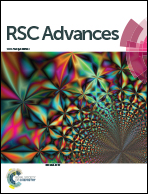Nickel cobalt sulfide nanoneedle array as an effective alternative to Pt as a counter electrode in dye sensitized solar cells†
Abstract
Self supported nickel cobalt sulfide (NCS) nanoneedles are directly formed on FTO glass substrates by sulphurization of nickel cobalt oxide nanoneedles (grown by a hydrothermal method) in the presence of a hydrogen sulfide and argon gas mixture. These NCS nanoneedles when used as a counter electrode for dye sensitized solar cells (DSSCs) show efficient catalytic activity towards the I−/I3− redox couple, and lead to an impressive efficiency of 6.9%, compared with 7.7% obtained with a Pt electrode in similarly constructed devices.


 Please wait while we load your content...
Please wait while we load your content...